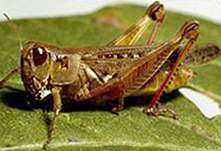Protein associated with learning implicated in causing grasshoppers to swarm

New research has found that a protein associated with learning and memory plays an integral role in changing the behaviour of locusts from that of harmless grasshoppers into swarming pests.
Desert Locusts are a species of grasshopper that have evolved a Jekyll-and-Hyde disposition to survive in their harsh environment. In their solitary phase, they avoid other locusts and occur in very low density. When the sporadic rains arrive and food is more plentiful, their numbers increase.
However, as the rains cease the locusts are driven onto dwindling patches of vegetation. This forced proximity to other locusts causes a little-understood transformation into their 'gregarious phase': they rapidly become very mobile, actively seek the company of other locusts, and thus form huge swarms that sweep the landscape in their search for food.
The new research, led by Dr Swidbert Ott from the University of Cambridge in collaboration with the University of Leuven, explored the role of a specific signalling protein in the locusts' brain, known as Protein Kinase A, in this transition. They found that this protein, which is typically associated with learning in other animals, has been co-opted to control the transition from solitary to gregarious behaviour in locusts.
They hypothesize that the process whereby locusts 'remember' the experience of crowding and modify their behaviour resembles learning. The 'learning' protein acts as a molecular switch in a social feedback loop, because gregarious behaviour ensures that crowding is maintained. The new results indicate that the biochemical mechanism that triggers locust swarming is similar to what enables humans and other animals to respond to social change.
Dr Ott added: "Learning is when you change your behaviour in the light of new experience, and this is what a locust needs to do when it gets caught up in the crowd. What is amazing is that the parallels don't just end there, they extend to the specific proteins that bring about the behavioural changes."
Desert locusts (Schistocera gregaria) are one of the most devastating insect pests, affecting 20% of the world's land surface through periodic swarms containing billions of locusts stretching over many square kilometres. Different species of locust continue to inflict severe economic hardship on large parts of Africa and China. In November 2008, swarms six kilometres long plagued Australia.
The research will be published this week in the journal PNAS.
More information: The paper 'A critical role for protein kinase A in the acquisition of gregarious behavior in Desert Loc' will be published on the PNAS Online Early Edition the week of December 19-23, 2011.
Journal information: Proceedings of the National Academy of Sciences
Provided by University of Cambridge

















